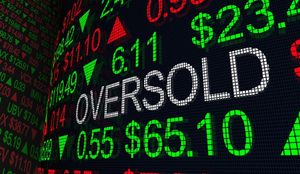After the US president threatened to unleash the Department of Justice on US beef packers, on the grounds of collusion, Tyson announced it was closing one of its plants and reducing production at others.
The price at meat counters has been stubborn, despite manipulated collapses in futures and reported cash prices.
Don’t Miss a Day: From crude oil to coffee, sign up free for Barchart’s best-in-class commodity analysis.The bigger question is if the US has started down the path of expanding its cattle herd, and increasing supplies.
My friend in the cattle industry called Monday afternoon to give me more information about the situation between the US administration and US beef packers, most notably Tyson. The stage was set for a showdown when the US president threatened to use the Department of Justice against the beef packing industry consisting of four major entities: JBS (a Brazilian company), Cargill (US), National Beef, (Brazil), and of course Tyson Foods (US). The point of contention has been, is, and will likely continue to be high beef prices at the meat counter. Recall the US president demanded lower beef prices, assuming the power his colleagues in Russia, China, and North Korea have over every aspect of every market, supply and demand be damned. His social media posts and directives worked on the futures markets (both live and feeder cattle), while he received some assistance from USDA as the latter took an axe to reported boxed beef prices, real or not. The problem was, though, prices US consumers were paying at the meat counter were not going down but rather continued to rise.
The situation presented an interesting argument. On one hand, there is the age-old view that packers are the New York Yankees, former Soviet Union, and the Empire from the Star Wars universe; literally an evil empire that works together to fix prices paid to producers and by consumers. This is the stance the US president was told to take after continued high US beef prices were used as the scapegoat for his party’s poor performance during the most recent election in early November. However, the tack the US president didn’t take was arguing the beef industry is a free market, and the fact prices at the counter remained high reflected a strong economy still being led by solid consumer demand. Which view is correct? In true commodity analyst fashion, I can confidently say, “Both, partly”.
Was there collusion among the Big Four packers? Yes. But this has most likely been the case as the industry consolidated down to the four major companies listed above, running smaller meat packers out of business along the way. Did demand from US consumers stay strong despite the high price of beef? Absolutely. I did a quick search of beef consumption per capita by country for 2025, and a World Population Review[i] returned these results: Still holding onto the top spot is Argentina at 46 kilograms (kg)[ii], or roughly 101 pounds (lbs) per person per year. (And the US president thinks he is going to pull supplies away from that demand? Really?) Second place surprised me a bit as Zimbabwe came in at 44.4 kg (98 lbs). The United States was a distant third at 38 kg (84 lbs).
Still, we know US demand for beef isn’t going away anytime soon. As an attendee at one of the Barchart Grain Merchandising and Technology Road Show meetings put it this summer, “We’ll know demand has changed when the payoff of a bet is a plate of chicken rather than a steak.” As the classic television commercial has reminded US viewers over the years, “Beef. It’s What’s for Dinner”.
Which brings us to the supply side, or as Clara Peller would ask, “Where’s the Beef?”. The most recent USDA Cold Storage report, before the US government shutdown, showed frozen beef supplies as of August 31, 2025. Reportedly, and since it is a USDA report all numbers come with an asterisk, “total pounds of beef in freezers were down 1 percent from the previous month but up 2 percent from last year”. At the same time, US cattle on feed as of September 1 was reportedly 11.08 million head (mh), up 1% from the previous month but down 1% from the previous year while cattle marketed during August came in at 1.78 mh, up 11% for the month but down 10% from the previous year. Additionally, US beef exports at the end of August were reportedly 465,300 mt, down 12% from the end of August 2024.
My interpretation of these numbers was US demand remained strong this past grilling season. If cattle marketed increased by 11% month-to-month (July to August), yet total beef in freezers decreased 1%, domestic demand had to be strong, particularly if exports continued to show a double-digit lag to the previous year, presumably tied to price and continued tight supplies. And if US demand stayed strong for high priced beef, what did this tell us about the US economy? About capitalism? About free markets? Or do any of those three exist these days?
What about our three reads on real fundamentals: Cash price, basis, and futures spreads? To be brutally honest, I’m not sure we can believe what we see in most of these at this point. The national cash index we see on quote screens seldom relate to what reported prices are coming from the industry. Yes, I know, there is a process of turning those reported prices into an index, and there can be a lag, particularly when cash prices are changing as dramatically as what we’ve seen this year. A case in point: my friend told me over the weekend cash bids had been dropped altogether, a common move by merchandisers in times of uncertainty. Monday afternoon he updated me with cash bids of $208 dollars being accepted. Last Friday’s Index price was $227. And that example pales in comparison to what we see in feeder cattle.
The fact futures were driven lower by social media posts from the US president while cash indexes stayed strong skewed our basis read, to the point of ridiculousness. Last Friday’s calculations came in at $12.55 over in live cattle, as compared to the previous 5-year high weekly close for last week of $6.75 over, and $25.50 over in feeder cattle versus the previous 5-year high weekly close for last week of $5.915 over. As Freddie Mercury, lead singer of Queen once asked, “Is this the real life? Is this just fantasy?”
Futures spreads have stayed bullish as well. Looking at last Friday’s closes in the live cattle market we see the December (LEZ25)-February (LEG26) settled at (-$0.325) as compared to the previous 5-year high weekly close of (-$0.475) and average of (-$1.725); the February-April (LEJ26) at (-$0.375) versus (-$1.75) and (-$3.60), and the April-June (LEM26) at $6.175 ($8.85 and $4.975). Note, though, the far deferred spread started to crack. The latest cattle on feed report, number of head as of November 1, showed 11.706 mh, up 3% from the previous month but still down 2% from the previous year. It’s possible – possible – the US cattle herd is starting to grow again. My friend also mentioned heifer retention is starting to go up, an early sign of growth in what is a long process of expansion.
Cattle markets will be in the commodity complex spotlight Tuesday (November 25) after both live and feeder futures opened and locked limit down Monday. As I mentioned to Jesse Allen on the Agriculture of America talk show, the futures market action reminded me of pre-Christmas 2003 when cattle locked limit down, day after day, following the first reported case of US bovine spongiform encephalopathy (BSE). It was that instance that brought about the expanded daily trading limits that exist in cattle futures heading into today’s session.
We’ll see what happens this holiday season.
[i] You can see the report here: (LINK)
[ii] The report states, “Data tracks food supply rather than actual consumption. Exact consumption values are likely slightly lower due to spoilage and food waste by consumers.”
On the date of publication, Darin Newsom did not have (either directly or indirectly) positions in any of the securities mentioned in this article. All information and data in this article is solely for informational purposes. For more information please view the Barchart Disclosure Policy here.
More news from Barchart





